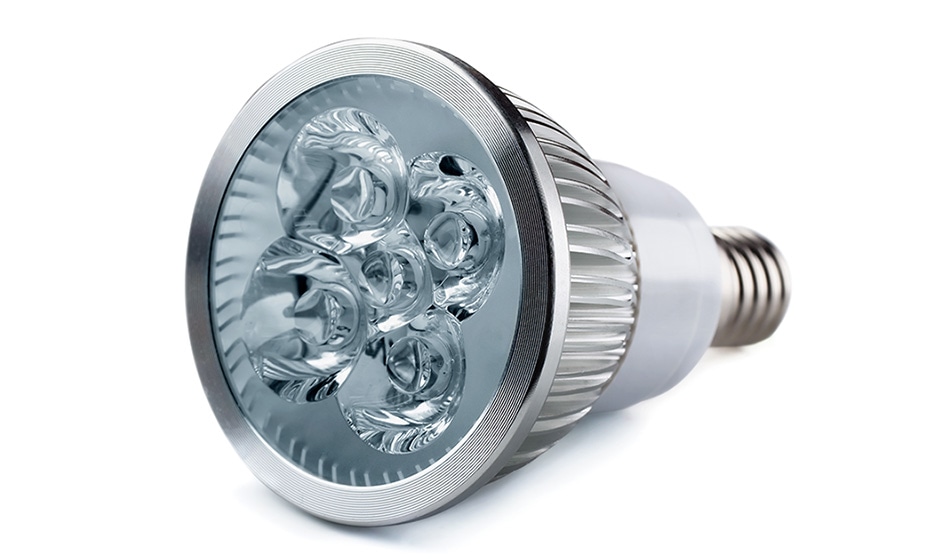-2.jpg) By Thomas HornigoldFeb 20 2018
By Thomas HornigoldFeb 20 2018LEDs are all around us in the modern era; they’re far more efficient and can be easier to manufacture than traditional bulbs, as well as being more environmentally friendly. But the technology is always improving, with particular emphasis on blue or higher-energy LEDs which can be the limiting factor in the lifetime of the much-sought-after white LEDs.
 Image credit: Coprid / Shutterstock
Image credit: Coprid / Shutterstock
In the past, optoelectronic discovery was often serendipitous, with researchers investigating the properties of a huge array of likely substances that are thought to be good candidates for better optoelectronic materials. Now, new research led by the University of California, San Diego, in collaboration with Chonnam National University in Korea, has used computer-aided discovery to find better materials for these LEDs. The discovery was published in Joule.
The specific material that has been discovered is a novel phosphor – light-emitting substance – that has been dubbed SLAO due to its constituent elements (Strontium, Lithium, Aluminium, and Oxygen). This is the first known material to be made of precisely this combination of elements, and consequently, there was no previous experimental evidence that could directly suggest its suitability as an LED candidate.
The advantage of this new phosphor is that lithium, aluminum, and oxygen are abundant elements in the Earth – crucial if you hope to mass-produce the LEDs – and the color quality for the new material is better than that of many old LEDs, rendering colors more vividly and accurately. It can be produced using existing industrial techniques if desired.
The key novelty to this new material is the means of discovery – SLAO was predicted by supercomputers before it was synthesized. The systematic, high-throughput computational approach was developed in the lab of Shyue Ping Ong, a nanoengineering professor at the UC San Diego Jacobs School of Engineering and lead principal investigator of the study.
Using this technique, it was possible to predict that SLAO would be stable in its performance and that it would have the ability to absorb light in the blue and near-UV range of the electromagnetic spectrum. The supercomputers also predicted high photoluminescence – that is, the ability of the substance to emit light of the appropriate frequency when excited by a higher-energy source.
This is far more efficient than any method with trial and error. "Calculations are quick, scalable and cheap. Using computers, we can rapidly screen thousands of materials and predict candidates for new materials that have not yet been discovered," Ong said.
To find the appropriate material, the researchers made a list of the most common elements that are used in phosphors – drawing on decades of experimental work in synthesizing these materials – and were surprised to find that no combinations of SLAO existed, despite the fact that each of these elements had been used individually in phosphors. They could then combine them in various ways using a data-mining algorithm, and perform basic calculations to estimate the efficiency and optoelectronic properties of the materials. The researchers were surprised by the success of this technique, and their ability to find a material that was not just theoretically possible.
"It's not only remarkable that we were able to predict a new phosphor compound, but one that's stable and can actually be synthesized in the lab," said Zhenbin Wang, a nanoengineering Ph.D. candidate in Ong's research group and co-first author of the study.
That process of synthesizing SLAO for the first time was a collaborative effort. Researchers in the lab of Joanna McKittrick, a materials science professor at the Jacobs School of Engineering, were the first to synthesize and test the properties of the new material. The recipe was then optimized by a team led by materials science professor Won Bin Im at Chonnam National University in Korea – taking the material from a lab prototype to something that could be built with industrial processes and as a component of a white LED.
They evaluated the LEDs using the Color Rendering Index (CRI), a scale that measures how accurately an LED can render the desired color on a scale from 0-100. Many commercial LEDs have CRI values at around 80. LEDs made with the new phosphor yielded CRI values greater than 90.
It is not a perfect LED material. The quantum efficiency of such a material is defined as the ratio of photons emitted in the desired wavelength to photons absorbed at higher energies – so a material with a quantum efficiency of 100% would emit a single photon for each that it absorbed. The quantum efficiency of this material is only 32%, which means that it requires more power to produce the same amount of light: the researchers note that this quantum efficiency could be improved with different materials and that in SLAO we see a trade-off where more accurate color-rendering requires more energy.
But, beyond the eventual uses of any one material, the technique in finding that substance will prove useful in the future. The Materials Virtual Lab, which Ong leads, will be using machine-learning and data-mining algorithms such as this one to develop materials for the next generation of solar cells, power cells, and LEDs; the potential for a brighter future for us all.
Disclaimer: The views expressed here are those of the author expressed in their private capacity and do not necessarily represent the views of AZoM.com Limited T/A AZoNetwork the owner and operator of this website. This disclaimer forms part of the Terms and conditions of use of this website.